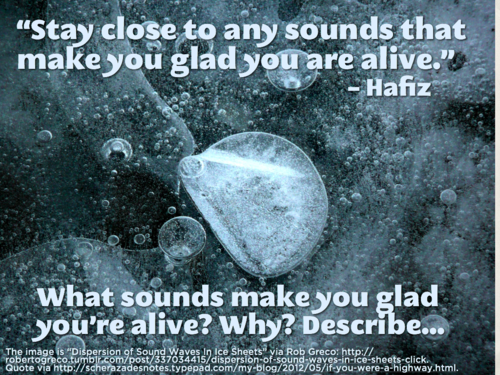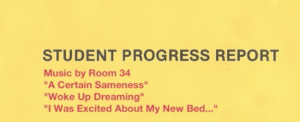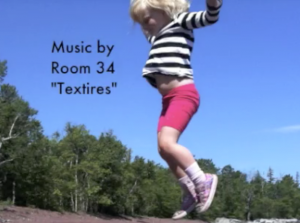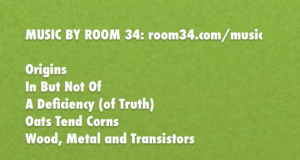This morning two posts about sound came up on my Tumblr feed. This one from Writing Prompts:
And this one from the On Being Blog: Sounds of Silence. The first post is a writing prompt that a teacher uses to inspire his junior high school students. While I don’t always like the prompts that he tumblrz (anyone using this as a verb?), I did really like this one. My quick answer: wind in the trees/reminds me of the Upper Peninsula of Michigan. For as long as I can remember, the sound of wind blowing through trees, especially aspens, like the ones that were on my family’s farm near Amasa, Michigan, makes me feel joyful and calm and content. Does this mean this sound makes me feel untroubled? What does that say about my desire to (almost) always stay in trouble? Hmmm….
The second Tumblr post is from On Being, the NPR “project delving into the human side of news stories + issues.” This post is about silence and how it has become increasingly difficult, with noise pollution and “human noise intrusion,” to listen to some of the quieter sounds emanating from nature.
It is our birthright to listen, quietly and undisturbed, to the natural environment and take whatever meanings we may. Long before the noises of mankind, there were only the sounds of the natural world. Our ears evolved perfectly tuned to hear these sounds-sounds that far exceed the range of human speech or even our most ambitious musical performances: a passing breeze that indicates a weather change, the first birdsongs of spring heralding a regreening of the land and a return to growth and prosperity, an approaching storm promising relief from a drought, and the shifting tide reminding us of the celestial ballet. All of these experiences connect us back to the land and to our evolutionary past.
While I don’t like the language that the author of this post, Gordon Hempton, uses to describe these quieter sounds of nature (It seems a bit too essentializing to me; it reinforces a rigid division/binary between humans and nature; and it envisions the “natural environment” as primarily a resource for us to use and from which to “take whatever meanings we may.”), I appreciate his emphasis on the value of being quiet(er) and our need to listen beyond ourselves.
I also like the idea of being quiet. As someone with two kids, one of which is (like me as a kid) exceptionally LOUD, I find that my tolerance for loud noise is rapidly depleting. A cacophony of sounds may excite and stimulate some, maybe even inspiring or provoking them into staying in trouble, but it usually only produces unhelpful anxiety in me.
In the second half of the post, Hempton discusses the one square inch project, a “sanctuary for silence at Olympic National Park.” To “protect and manage the natural soundscape in Olympic Park,” one square inch of land, about a two hour hike into the backcountry, is marked off and managed as the quietest place in the United States. Cool. I’d like to go there…someday.
I love really quiet places. One of the quietest places that I’ve found in Minneapolis is the parking garage at the downtown library. It’s awesomely quiet. What’s so “natural” about that space, you may ask? I’m not sure, but what is nature/natural anyway? Should we imagine such a strict division between natural and constructed. I don’t think so. In pondering these questions, I’ve been racking my brain trying to think of a recent book that explores the biodiversity of urban environments (and the resiliency of non-human life forms?) but I can’t remember the title and my google searches are coming up empty.
I want to put all of this discussion of the value of being quiet(er) and my appreciation of calm, peaceful sounds like the wind in the trees, BESIDE some other sounds that I’ve been valuing lately: Room 34’s music. His music is great as a soundtrack to my various troubling digital videos. In my three recent videos, posted on Vimeo–Student Progress Report: Undisciplined Account; Stories from the UP; and TROUBLE, an introduction–I’ve used Room 34’s music, from several different albums, to help set a troubling mood. Here are screen shots of my credits from each video:
You couldn’t call any of the songs that I’ve used from Room 34 as nature-filled/natural (he uses synth sounds and smartphone music apps) or peaceful and calming (most of them are quite unsettling). Yet, his music is usually quiet/fairly subdued and often joyful. Well, to me, at least. Every time I hear “Wood, Metal and Transistors” at the end of TROUBLE, an introduction, it makes me laugh (maybe giggle is a better word?).
His music helps me to convey a contemplative and uneasy mood for many of my stories. I think I’m using his music partly to unsettle my own impulses to create stories that are easy and that just (that is, uncritically) “feel good.” And I’m using his music to (hopefully) encourage others to not easily consume my stories, but to think about and react to them.
In reflecting on it more, I think I’m also using his music because it has a haunting quality; the electronic layers of sounds always seem to be hinting at something deeper and darker that necessarily exists beside the joy we may be experiencing. I like that idea; Room 34’s music enables me to realize aurally (is there a sound equivalent for “visualize”?) contradictory emotions beside each other, emotions like joy and grief/happiness and sorrow.




